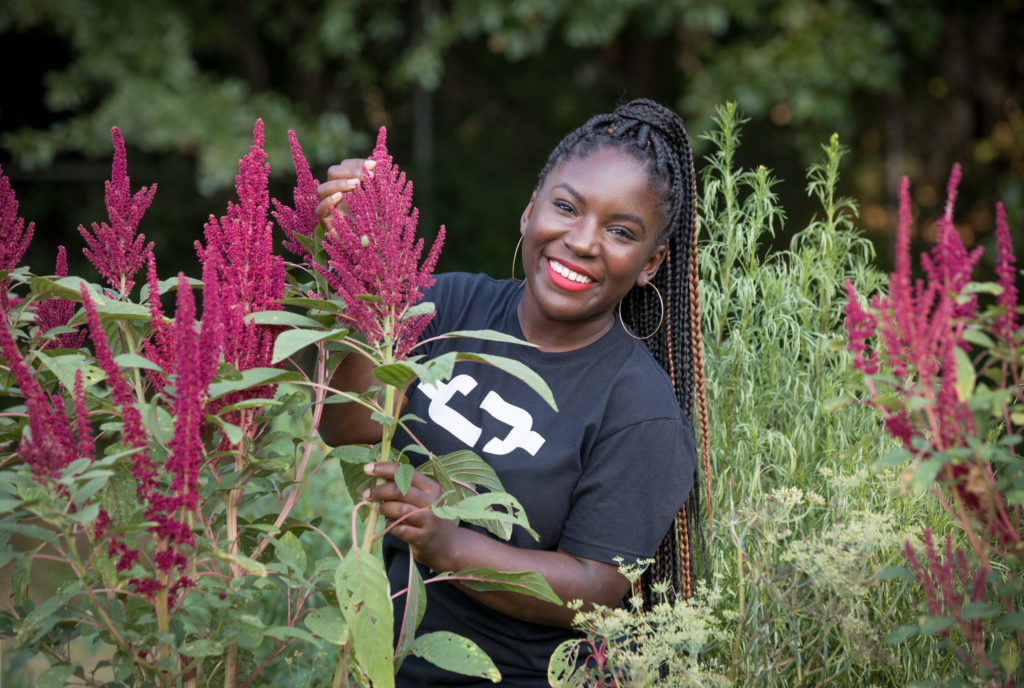The boat to Sapelo Island one morning this summer included an avid gardener and aspiring landscape architect: Whitney Barr, a Master of Landscape Architecture candidate at UGA’s College of Environment and Design.
Barr spent her summer in immersive research, planting and caring for two traditional heritage crops of the Saltwater Geechee community: red peas and sugar cane. Her work was conducted under the direction of Nik Heynen, professor of geography and a member of UGA’s Marine Institute faculty. Heynen recently co-founded the Cornelia Walker Bailey Program on Land and Agriculture based on Sapelo.
“I wanted to fully immerse myself in the culture and develop genuine relationships with members of Sapelo’s community,” Barr said. “I combined my love of gardening with my appreciation of the community and its history and set out to learn as much as I could about the complicated yet beautiful story of resilience within this amazing place.”
As a researcher and an African American woman raised by sharecroppers in South Carolina, Barr has an especially keen insight into what is meant by “community” in places often overlooked and underserved.
“I continue to be inspired by the resilience of the people of Sapelo,” she said, “and every time I come on the island, I realize that there is so much more for me to learn about this place, the African Diaspora and our deep connections to food and land.”
Sapelo Island is about 11 miles long and sits almost exactly halfway between Tybee and Jekyll islands, just south of St. Catherines. Unlike the highly developed tourist destinations of Tybee and Jekyll, Sapelo remains removed from the mainland. In the small community of Hog Hammock, there is one convenience store and no schools, no medical facility and no grocery store. Residents rely on themselves for food and medicinal needs, or go to the mainland by ferry as those needs arise. Approximately 70 people reside there full time, all of them direct descendants of West Africans who were enslaved and brought over from Africa more than 150 years ago. Barr plans to make her research at Sapelo part of her thesis.
Barr is a recipient of the first Landscape Architecture Foundation’s Honor Scholarship for Inclusive Community Design, a $10,000 scholarship that supports students who have shown a commitment to underserved urban communities and who want to address community-scale design. While working for Delta Air Lines after graduating from Spelman College in Atlanta, Barr volunteered for urban garden work. She also worked as a digital marketer for a social enterprise owned by Open Hand Atlanta, a nonprofit that prepares and delivers more than 5,000 nutritious meals a day to seniors battling chronic health conditions. Outside of the office, Barr also reignited and led the on-site garden. Produce was used to supplement cooking matters and nutrition workshops with culturally relevant crops. She plans to make a career in landscape design that is dedicated to approaching healthier food systems by creating healthy community garden systems that celebrate the African Diaspora throughout urban and rural settings.
“When I was managing the produce garden in Atlanta, I became intrigued by the idea of how to get people to come to the garden and stay, not just pick up produce and leave. I wanted to learn how to design places to scale, with an understanding of how spatial definition affects a person’s experience, how we can encourage interaction and the creation of community,” Barr said.
“I hope to bring my appreciation of food and gardening to a new level using my design skills,” she said.“My time on Sapelo this past summer was both rewarding and inspiring; I will especially treasure my experience there under the guidance of knowledge handed down to me from the island’s matriarch, Cornelia Walker Bailey, whose book God, Dr. Buzzard and the Bolito Man is an excellent portrait of life on Sapelo.”
